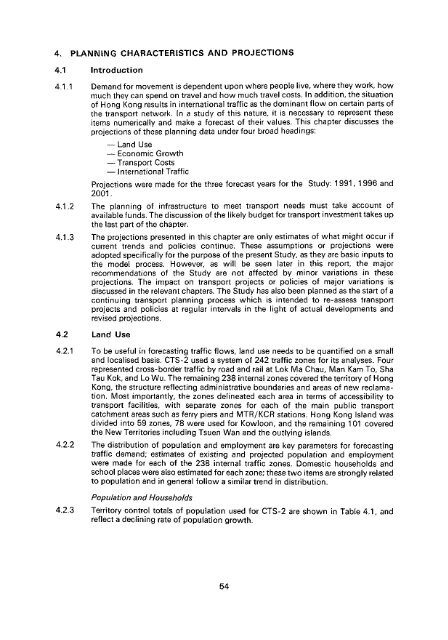Untitled - HKU Libraries - The University of Hong Kong
Untitled - HKU Libraries - The University of Hong Kong
Untitled - HKU Libraries - The University of Hong Kong
- No tags were found...
You also want an ePaper? Increase the reach of your titles
YUMPU automatically turns print PDFs into web optimized ePapers that Google loves.
4.4.1 introduction4.1.1 Demand for movement is dependent upon where people live, where they work, howmuch they can spend on travel and how much travel costs. In addition, the situation<strong>of</strong> <strong>Hong</strong> <strong>Kong</strong> results in international traffic as the dominant flow on certain parts <strong>of</strong>the transport network. In a study <strong>of</strong> this nature, it is necessary to represent theseitems numerically and make a forecast <strong>of</strong> their values. This chapter discusses theprojections <strong>of</strong> these planning data under four broad headings:— Land Use— Economic Growth— Transport Costs— International TrafficProjections were made for the three forecast years for the Study: 1991, 1996 and2001.4.1.2 <strong>The</strong> planning <strong>of</strong> infrastructure to meet transport needs must take account <strong>of</strong>available funds. <strong>The</strong> discussion <strong>of</strong> the likely budget for transport investment takes upthe last part <strong>of</strong> the chapter.4.1.3 <strong>The</strong> projections presented in this chapter are only estimates <strong>of</strong> what might occur ifcurrent trends and policies continue. <strong>The</strong>se assumptions or projections wereadopted specifically for the purpose <strong>of</strong> the present Study, as they are basic inputs tothe model process. However, as will be seen later in this report, the majorrecommendations <strong>of</strong> the Study are not affected by minor variations in theseprojections. <strong>The</strong> impact on transport projects or policies <strong>of</strong> major variations isdiscussed in the relevant chapters. <strong>The</strong> Study has also been planned as the start <strong>of</strong> acontinuing transport planning process which is intended to re-assess transportprojects and policies at regular intervals in the light <strong>of</strong> actual developments andrevised projections.4.2 Land Use4.2.1 To be useful in forecasting traffic flows, land use needs to be quantified on a smalland localised basis. CTS-2 used a system <strong>of</strong> 242 traffic zones for its analyses. Fourrepresented cross-border traffic by road and rail at Lok Ma Chau, Man Kam To, ShaTau Kok, and Lo Wu. <strong>The</strong> remaining 238 internal zones covered the territory <strong>of</strong> <strong>Hong</strong><strong>Kong</strong>, the structure reflecting administrative boundaries and areas <strong>of</strong> new reclamation.Most importantly, the zones delineated each area in terms <strong>of</strong> accessibility totransport facilities, with separate zones for each <strong>of</strong> the main public transportcatchment areas such as ferry piers and MTR/KCR stations. <strong>Hong</strong> <strong>Kong</strong> Island wasdivided into 59 zones, 78 were used for Kowloon, and the remaining 101 coveredthe New Territories including Tsuen Wan and the outlying islands.4.2.2 <strong>The</strong> distribution <strong>of</strong> population and employment are key parameters for forecastingtraffic demand; estimates <strong>of</strong> existing and projected population and employmentwere made for each <strong>of</strong> the 238 internal traffic zones. Domestic households andschool places were also estimated for each zone; these two stems are strongly relatedto population and in general follow a similar trend in distribution.Population and Households4.2.3 Territory control totals <strong>of</strong> population used for CTS-2 are shown in Table 4.1, andreflect a declining rate <strong>of</strong> population growth.54
















